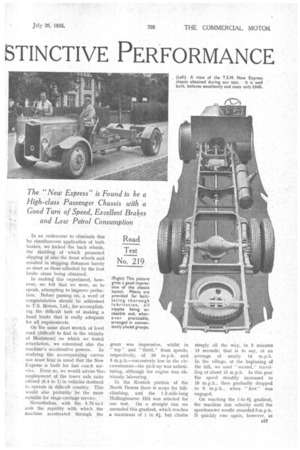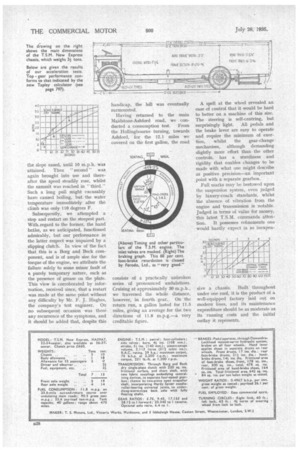THE NEW T.S. M. Reveals Di
Page 44

Page 45

Page 46

If you've noticed an error in this article please click here to report it so we can fix it.
STINCTIVE PERFORMANCE
SEARCHING without being unfairly exacting, the system of road-testing that has been evolved and standardized by this paper is so thorough that a machine coming through it without some weakness having been revealed, may confidently be regarded as having a first-rate performance. The fact that comparatively few vehicles encounter complete success constitutes proof of this statement.
The new T.S.M. single-decker chassis, which we tested out last week, only narrowly missed emerg in from the trial with an absolutely • clean sheet. Its rate of fuel conbumption is low, its accelerative powers are high, and its brake systems are among the most effective with which we are acquainted. Capable of high speeds, the machine is equipped with a first-rate suspension system, whilst its steering is both light and steady.
In our issue dated March 22 last, in which' the New Express was fast announced, a full description of the chassis was published; consequently there is no need for particulars of its make-up to be included here. It should be noted, however, that a different carburetter is now in use, namely, a Solex Self-Starting model.
Having a long stroke (140 ram.) and a fairly high compression ratio (51 to 1), the engine is a highefficiency unit, with a liking for r.p.m. and a tendency to pink on fullthrottle openings at low speeds. Seated behind the open louvres on the top of the bonnet, where we received the full force of the engine noise, we may, however, have formed a somewhat exaggerated
e26 opinion of this characteristic. When at the wheel it was far dess apparent, and, to a passenger within the body, it would hardly be audible.
'Despite the high axle ratio of 5.75 to 1, and a power-to-weight ratio equivalent to about 0.5 b.h-.P. per cwt., the vehicle picks up well in top • gear from low road speeds and takes moderate gradients in its stride.
An important feature of a chassis designed for fast coach work is the brake system. On the New Express there are two entirely separate arrangements. The pedal actuates brakes on all four wheels, a Dewandre vacuum-servo cylinder amplifying the force and a Lockheed hydraulic system transmitting it to the wheels, where it is applied to the shoes by cylinders, mounted awak from the heat of the drums.
• The hand lever operates, by purely mechanical Tr tans, further pairs of shoes, in arums that are of smaller diameter and fixed within and concentric with the foot-brake drums, on only the rear wheels.
Either brake, when fully applied, causes a retardation just insufficient to lock the wheels on good gripping surfaces. An accompanying graph reveals, the excellent results obtained. . There is a momentary time lag with the servo brake, but its duration is almost
negligible.
. In an endeavour to eliminate this by simultaneous application of both brakes, we locked the back wheels, the skidding of which promoted slipping of also the front wheels and resulted in stopping distances barely as short as those afforded by the foot brake alone being obtained.
In making this experiment, however, we felt that we were, so to speak, attempting to improve perfection. Before passing on, a word of congratulation should be addressed to T.S. Motors, Ltd., for accomplishing the difficult task of making a hand brake that is really adequate for all requirements.
• On the same short stretch of level road (difficult to find in the vicinity of Maidstone) on which we tested retardation, we ex'amined also the
machine's accelerative powers. In studying the• accompanying curves one must bear in mind that the New Express is built for fast coach service. Even so, we would advise the employment of the lower axle ratio offered(6.4 to 1) in vehicles destined to operate in difficult country. This wonld also probably be the more suitable for stage-carriage service.
Nevertheless, with the 5.75-to-1 axle the rapidity with which .the machine accelerated through the gears was impressive, whilk in " top" and "third," from speeds, respectively, of 10 m.p.h. and 5 m.p.h.—excessively low in the circumstances—the pick-up was unhesitating, although the engine was obviously labouring.
In the Kentish portion of the North Downs there is scope for hillclimbing, and the 1.2-mile-long Hollingbourne Hill was selected for our test. On a straight run we ascended this gradient, which reaches a maximum of 1 in 61, but climbs
steeply all the way, in 5 minutes 15 seconds; that is to say, at an average of nearly 14 m.p.h. In the village, at the beginning of the hill, we used " second," travelling at about 15 m.p.h. In this gear the speed steadily increased to 18 m.p.h., then gradually dropped to 6. m.p.h., when " first " was engaged.
On reaching the 1-in-61 gradient, the machine lost velocity until the speedometer needle recorded 5 m.p.h. It quickly rose again, however, as the slope eased, until 10 m.p.h. was attained. Then " second " was again brought into use and thereafter the speed steadily rose, whilst the summit was reached in "third. Such a long pull might excusably have caused boiling, but the water temperature immediately after the climb was only 110 degrees F.
Subsequently, we attempted a stop and restart on the steepest part. With regard to the former, the hand brake, as we anticipated, functioned .dmirably, but our performance in the latter respect was impaired by a slipping clutch. In view of the fact that this is a Borg and Beck component, and is of ample size for the torque of the engine, we attribute the failure solely to some minor fault of a purely temporary nature, such as the presence of grease on the plate. This view is corroborated by information, received since, that a restart was made at the same point without any difficulty by Mr. F. J. Hughes, the company's test engineer. On no subsequent occasion was there any recurrence of the symptoms, and it should be added that, despite this handicap, the hill was eventually surmounted.
Having returned to the main Maidstone-Ashford road, we conducted a consumption test. From the Hollingbourne turning, towards Ashford, for the 12.1 miles we covered on the first gallon, the road consists of a practically unbroken series of pronounced undulations. Cruising at approximately 30 m.p.h., we traversed the whole distance, however, in fourth gear. On the return run, a gallon lasted for 11.5 miles, giving an average for the two directions of 11.8 mpg.—a very creditable figure. A spell at the 'wheel revealed an ease of control that it would be hard to better on a machine of this size. The steering is self-centring, but surprisingly light. All pedals and the brake lever are easy to operate and require the minimum of exertion, whilst the gear-change mechanism, although demanding slightly more effort than the other controls, has a sturdiness and rigidity that enables changes to be made with what one might describe as positive precision—an important point with a separate gearbox.
Full marks may be bestowed upon the suspension system, even judged by luxury-coach sta,ndards, whilst the absence of vibration from the engine and transmission is notable. Judged in terms of value for money, this latest T.S.M. commands attention. It possesses refinements one would hardly expect in so inexPen-.
sive a chassis. Built throughout under one roof, it is the product of a well-equipped factory laid out on modern lines, and its maintenance expenditure should be as moderate as its running costs and the initial outlay it represents.




































































































